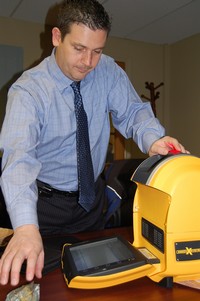 The steadfast prospector is always looking for a more expedient way to find that needle in the haystack.
The steadfast prospector is always looking for a more expedient way to find that needle in the haystack.
The Innov-X Systems Inc. handheld and portable XRF (X-ray fluorescent) spectrometry and the XRD (X-ray diffraction) analyzer systems are the tools to help speed up that process, according to Bob Komarechka, respected Sudbury geologist and sales consultant for Innov-X Canada.
"You get a great deal of information for 30 elements in a period of a minute," he said. "So you can start seeing interrelationships of different elements and then you can start recognizing alteration patterns…it’s a huge amount of information that’s collected in a short time frame that can be applied in all kinds of interesting ways."
The company began in 2001 as a four-person start-up in Woburn, Massachusetts, site of its head office, research and development, and manufacturing facility. It is now a 200-employee firm with sales and service offices located in Europe, Asia, Australia and Canada.
XRF spectrometry is used to identify elements in an object and quantify the amount of those elements present. Possible mining applications are remote exploration; site mapping; ore grade control and selection; continuous process monitoring of liquids, slurries and cores; down hole characterization; environmental waste management; and heavy equipment maintenance.
"The biggest innovation was taking the X-ray tube and making it small enough and tough enough to put into a handheld device," said Phil Miller, product manager.
It is this portability and convenience of bringing the "lab" to the field that makes it attractive to exploration and mining companies, as well as other industries requiring timely analysis.
"In grassroots exploration, oftentimes more than 70 per cent of the samples are not economic and more than 50 per cent are not worth following up," Komarechka said. "Lots of samples are picked up with the potential of good value, but you don’t know until they come back from the lab, and you don’t want to miss anything, so you collect the sample."
Komarechka touted the device’s ability to provide instant feedback, allowing the geologist to decide which samples are sent to the lab, saving time and money.
"It won’t replace the lab, but it will make sure those samples sent to the lab have merit, and you are not wasting money on samples that don’t have anything in them."
The concept
Innov-X has taken the X-ray fluorescent tube and efficiently integrated it with handheld GPS and portable computers using wireless communications. Using an X-ray tube eliminates the need for radioactive isotopes, minimizing some of the regulatory requirements.
Miller equates the X-ray tube with a flashlight that emits energy, or light, when turned on. Similarly, the XRF handheld sends out high energy X-ray photons, striking the sample. The photon enters the innermost shell of the atoms, hitting an inner electron and moving it out of its orbit, leaving a hole. A higher energy electron then drops into the lower energy hole. As it drops down, it releases a photon of specific energy, unique to each element’s shell. The detector reads this unique energy and relates it to the specific element. The number of photons released of that energy relates to the concentration of that element.
"Every element has a characteristic set of energy peaks for multiple shell transition drops, so I get a spectrum with energy in counts," Miller said.
Lightweight, durable
The handheld analyzer uses a 0.8-centimetre window and can penetrate three millimeters deep in solid rock and about one centimetre into soil. It is lightweight, durable and uses four watts. The tube has two power settings and filters, which means it can measure more elements because different elements fluoresce at different energy levels. It has AC power or a four to five-hour lithium battery.
The portable X-50 is a closed-beam system requiring the sample to be physically placed within the unit’s chamber. It weighs about 10 kilograms, and has improved detection limits three times that of a handheld unit for some elements. Its tube has three power settings and five primary beam filters. It runs on AC power or a three-hour lithium battery.
Three modes
Both units use three modes: soil, mineral and alloy and can read as many as 30 elements within a detectable range generally from 10 to 100 parts per million (ppm).
The handheld can be interfaced with GPS (global positioning system) and GIS (geographic information system) technology, which means data can be collected with the XRF, represented spatially and mapped at each reading site, quickly providing geo-referenced colour-coded maps and an overall picture of the explored area. Collected field data can be sent back the same day to head office where information is reviewed and strategic decisions made directing further exploration.
"I think it will be the way of the future," Komarechka said.
The XRD works on the principle of X-rays being reflected off crystal lattice layers of the mineral within a closed-beam unit. It produces a spectrum from the sample that is compared to a library of known minerals, which matches to and determines the concentration of each element present up to one per cent. The portable XRD technology was developed by NASA and will be used on the 2011 Mars mission.
All products are regulated by Health Canada and certified by Natural Resources Canada. The handheld device, being an open-source X-ray beam, requires operator certification, which Innov-X provides.
While hopeful prospectors continue to search for the motherlode, Innov-X Systems may bring them one step closer and sooner to finding it.


